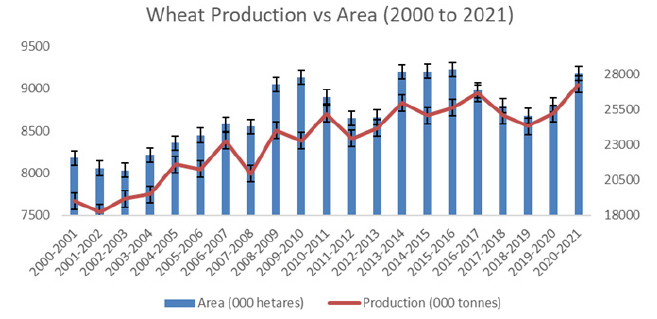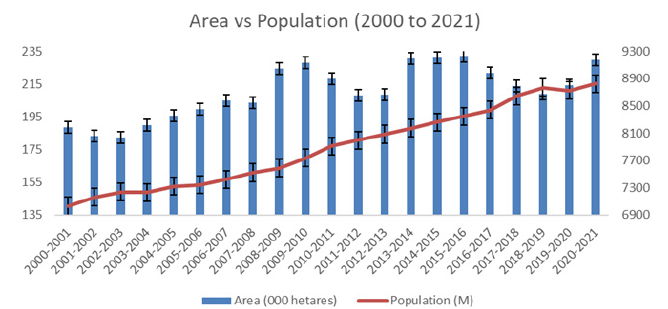- Submissions

Full Text
Environmental Analysis & Ecology Studies
Two Decades of Twenty Ist Century: Population and Wheat Growth of Pakistan
Muhammad Waseem2*, Qurban Ali1, Shahab Anwar1, Sarfraz Qamer1, Hafiz Tassawar Abbas1 and Ghulam Khaliq1
1Institute of Molecular Biology and Biotechnology, University of Lahore, Lahore, Pakistan
2Lasbela University of Agriculture, Water and Marine Science, Pakistan
*Corresponding author: Muhammad Waseem, Lasbela University of Agriculture, Water and Marine Science, Uthal, Lasbela, Pakistan
Submission: January 28, 2022; Published: August 23, 2022

ISSN 2578-0336 Volume10 Issue1
Introduction
Pakistan is divine with natural as well as human resources. Pakistan’s economy already had impulsive growth pattern during the last 20 years, with consistent flourishing and life cycle facing tasks in achieving durable and comprehensive growth. Vulnerable economic growth was triggered by unaddressed long-lasting essential issues for example, unprofitable State-Owned Enterprises (SOEs), pathetic external situation due to inadequate export volume and poorly develop energy segment, little reserves and stock.
Even before the COVID-19 pandemic hit Pakistan’s economy, the government of Pakistan started implementing decisive and far-reaching reforms in every (agriculture) sector of the economy. The FY2021 began in the midst of the most severe global health crisis experienced in modern history. Pakistan’s economy, like rest of the world, has struggled to combat the economic consequences of COVID-19 shock through prompt measures for supporting the economy and saving the lives and livelihoods. Wheat is the main staple crop of the country. For achieving the target of food security of the Pakistan sustainable production of wheat according to the population growth is essential. Self-reliance in wheat has been a core objective of every government. area, production and population The Human Resource of a country plays a significant part not only in the economic progress but also for the social well-being of the country. But, huge population mass and deficiency of appropriate management of human resources may clue to social distress and decrease economic show. For growing population growth, Pakistan is facing trouble in ideal social spending i.e. health care, education, housing and unemployment etc. In this situation, the start and increase of COVID-19 has additional provoked the condition. Pakistani government has taken numerous steps to overhaul the poorly structure of the economy and to gadget curative actions particularly for human capital development. Pakistan, being the 5th most populous country and having 9th largest labour force in the world, adds a large number to its labor force every year.
The results from Figure 1 showed that the area and production of wheat was found variable throughout the studied years from 2000 to 2021. It was found that the area and production was observed higher during 2000-2001 as compared with next two years performance. The highest area and production were set up for years 2008 to 2010, 2013 to 2016 and year 2021. The higher production indicated that the performance of wheat varieties and germplasm was with higher potential. The production and area was lower for 2017-2020 which indicated that there may be less availability of resources inputs and climatic factor especially high rainfall near to maturity of wheat. The production and area was lower during year 2020 was may be due to COVID-19 which caused reduction in production [1].
Figure 1:Year wise comparison between wheat production and area from (2000-21).

The finding from Figure 2 illustrated that the population and wheat production of Pakistan closely related and was found to be variable throughout the studied years from 2000 to 2021. Increasing population trend was observed linear as shown in Figure 2 from 2000 to 2021. Wheat production was found non linear especially in year 2001to 2003 and 2018-2020 as expressed Figure 2. A linear and highest production trend in wheat production was shown 2004-05, 2008-09, 2013-14, 2016-17 and 2020-21 as compared to population growth. Increasing trend in productions was due to availability of timely inputs, in addition to sufficient rainfall.
Figure 2: Association between Population and wheat production from (2000-21).

Figure 3 revealed that the population and wheat area of Pakistan directly linked and altered right through the considered years from 2000 to 2021. Population increasing trend of Pakistan was viewed linear from 2000 to 2021. Wheat cultivated area was examined non skewed and maximum especially from year 2008 to 2010, 2013-2016 and 2020-21. Minimum wheat area and 2018- 2020 as expressed Figure 2. A linear and highest production trend in wheat production was not in relation to population was found in 200-2003 as shown in Figure 3. This decreased in area reduction of wheat was due to Government policies and farmer preference about the cultivation of wheat [2].
Figure 3: Year wise comparison between wheat area and Population from (2000-21).

The results from Figure 4 indicated that overall liner association was found in wheat area, production and population. Regression values showed that population increased gradually from 2000 to 2021 and also a similar situation was noted in area cultivation of wheat in straight line with little increase in comparisons to populations. Variations in wheat productions was changed (increased or decreased) due to area changed and other planting inputs factor, government policies, timely rainfall, contribution of rain fed area and timely crushing of sugarcane, subsidized fertilizer rate, preference of farmer towards crop cultivations.
Figure 4:Regression analysis for area, production and population.

References
- GOP, Chapter 2nd: Agriculture (2000…………..2021). Economic Survey of Pakistan, Finance and Economic Affairs Division, Islamabad, Pakistan.
- GOP, Chapter 13th: Population, Labor Force and Employment (2000…………..2021). Economic Survey of Pakistan, Finance and Economic Affairs Division, Islamabad, Pakistan
© 2022 © Muhammad Waseem. This is an open access article distributed under the terms of the Creative Commons Attribution License , which permits unrestricted use, distribution, and build upon your work non-commercially.
 a Creative Commons Attribution 4.0 International License. Based on a work at www.crimsonpublishers.com.
Best viewed in
a Creative Commons Attribution 4.0 International License. Based on a work at www.crimsonpublishers.com.
Best viewed in 







.jpg)






























 Editorial Board Registrations
Editorial Board Registrations Submit your Article
Submit your Article Refer a Friend
Refer a Friend Advertise With Us
Advertise With Us
.jpg)






.jpg)














.bmp)
.jpg)
.png)
.jpg)










.jpg)






.png)

.png)



.png)






